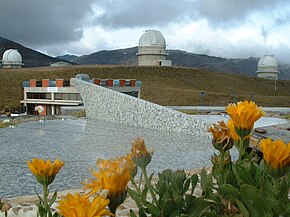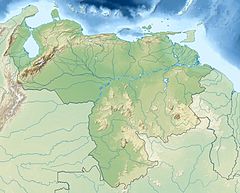 | |
| Observatory code | 303 |
|---|---|
| Location | Mérida, Venezuela |
| Coordinates | 8°47′11″N 70°52′19″W / 8.78639°N 70.87189°W / 8.78639; -70.87189 |
| Altitude | 3,600 m (11,800 ft) |
| Established | 1970 |
| Website | cida |
 | |
| | |
| [edit on Wikidata] | |
The Llano del Hato National Astronomical Observatory (Spanish: OAN de Llano del Hato, or Observatorio Astronómico Nacional de Llano del Hato, code: 303) is an astronomical observatory in Venezuela. It is 3600 meters above sea level and is the country's main observatory. It is situated above the village of Llano del Hato in the Venezuelan Andes, not far from Apartaderos which lies about 50 kilometers north-east of Mérida, Mérida State.
Description
This facility is the closest major optical observatory to the equator lying at 8 degrees and 47.51 minutes north. It therefore has access to most parts of both the northern and southern skies. It benefits from a very dark site, and its altitude of 3,600 meters (12,000 feet) above sea level means atmospheric turbulence is greatly reduced.
The observatory is under the auspices of the Centro de Investigaciones de Astronomia (CIDA), the main astronomical research body in Venezuela. CIDA conducts many projects in collaboration with other research organizations, academic institutions and international bodies. It also conducts valuable research in its own right and has a record that includes several important discoveries.
There are four large optical telescopes, each in its own cupola or dome: a 1-m Askania Schmidt camera (one of the largest telescopes of this type in the world), a 65-cm Zeiss refractor, a 1-m Zeiss reflector and a 50-cm Askania double astrograph. These instruments were acquired by the Venezuelan government 1954 and installed at Llano del Hato in early 1955. The observatory also has a museum and exhibition centre where visitors can learn about the work of the observatory and CIDA as well as astronomy in general.
The Quasar Equatorial Survey Team (QUEST) project is a joint venture between Yale University, Indiana University, and CIDA to photographically survey the sky. It now uses the 48 inch (1.22-m) aperture Samuel Oschin telescope at the Palomar Observatory with a digital camera, an array of 112 charge-coupled devices. Previously, it used the 1.0-metre Schmidt telescope of the Llano del Hato National Astronomical Observatory.
List of discovered minor planets
At OAN de Llano del Hato, Mérida, a total of 50 minor planets have been discovered and credited to the astronomers Orlando Naranjo, Jürgen Stock, Ignacio Ferrín and Carlos Leal:
| 9357 Venezuela | 11 January 1992 | list |
| (9605) 1992 AP3 | 11 January 1992 | list |
| (10344) 1992 CA2 | 12 February 1992 | list |
| (11089) 1994 CS8 | 8 February 1994 | list |
| 11193 Mérida | 11 December 1998 | list |
| 12359 Cajigal | 22 September 1993 | list |
| 12360 Unilandes | 22 September 1993 | list |
| 12366 Luisapla | 8 February 1994 | list |
| 12367 Ourinhos | 8 February 1994 | list |
| 12758 Kabudari | 22 September 1993 | list |
| (14005) 1993 SO3 | 22 September 1993 | list |
| (14918) 1994 BP4 | 21 January 1994 | list |
| 15050 Heddal | 12 December 1998 | list |
| 15453 Brasileirinhos | 12 December 1998 | list |
| (16565) 1992 CZ1 | 12 February 1992 | list |
| 16645 Aldalara | 22 September 1993 | list |
| 17494 Antaviana | 11 January 1992 | list |
| (17873) 1998 XO96 | 11 December 1998 | list |
| (23501) 1992 CK1 | 12 February 1992 | list |
| (29691) 1998 XH96 | 11 December 1998 | list |
| (29692) 1998 XE97 | 11 December 1998 | list |
| (31384) 1998 XE96 | 11 December 1998 | list |
| (31385) 1998 XF96 | 11 December 1998 | list |
| (35678) 1998 XW96 | 11 December 1998 | list |
| 38628 Huya | 10 March 2000 | list |
| (48565) 1994 CA9 | 8 February 1994 | list |
| (49430) 1998 XZ96 | 11 December 1998 | list |
| (56065) 1998 XB97 | 12 December 1998 | list |
| (59151) 1998 XK96 | 12 December 1998 | list |
| (66189) 1998 XA97 | 12 December 1998 | list |
| 74400 Streaky | 11 December 1998 | list |
| 79864 Pirituba | 11 December 1998 | list |
| 79889 Maloka | 8 January 1999 | list |
| (91210) 1998 XS96 | 11 December 1998 | list |
| (96609) 1999 AQ35 | 9 January 1999 | list |
| (120997) 1998 XT96 | 11 December 1998 | list |
| 127870 Vigo | 24 March 2003 | list |
| 128166 Carora | 27 August 2003 | list |
| (137096) 1998 XG97 | 11 December 1998 | list |
| 149528 Simónrodríguez | 24 March 2003 | list |
| 159776 Eduardoröhl | 2 May 2003 | list |
| 161278 Cesarmendoza | 24 March 2003 | list |
| 189310 Polydamas | 3 January 2006 | list |
| 196476 Humfernandez | 2 May 2003 | list |
| 201497 Marcelroche | 2 May 2003 | list |
| (237422) 1999 AF35 | 9 January 1999 | list |
| 347940 Jorgezuluaga | 30 March 2003 | list |
| 366272 Medellín | 30 March 2003 | list |
| (368628) 2004 UJ10 | 20 October 2004 | list |
| (423624) 2005 WZ156 | 27 November 2005 | list |
| Co-discovery made with: O. A. Naranjo J. Stock I. R. Ferrín C. Leal anomaly in MPC's data base as discovery observation was made by A84 in Turkey | ||
|---|---|---|
References
- "Minor Planet Discoverers (by number)". Minor Planet Center. 11 June 2017. Retrieved 24 June 2017.